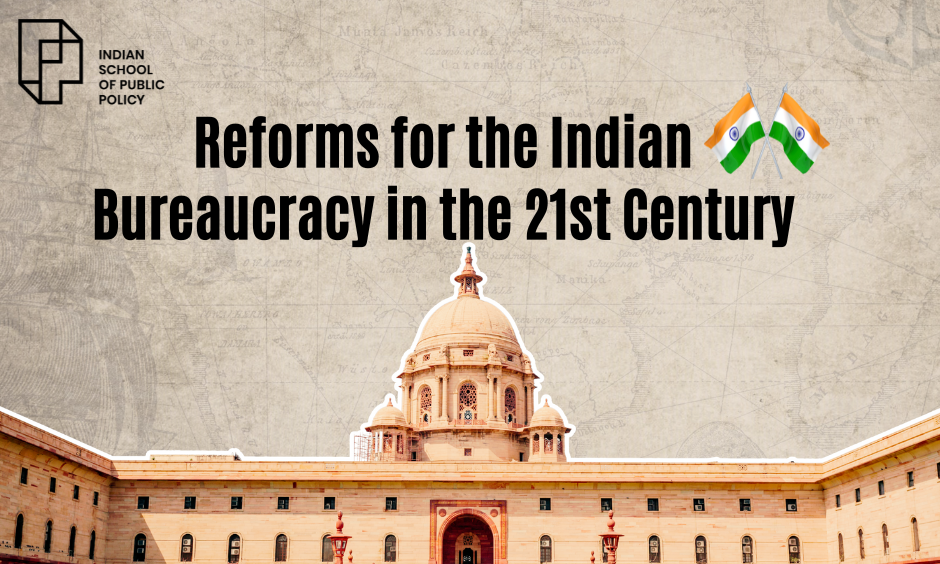
Reforms for the Indian Bureaucracy in the 21st Century

The Indian bureaucracy is one of the largest and most complex administrative structures in the world. Rooted in a colonial legacy, it has played a crucial role in nation-building, governance, and policy implementation since independence. However, in the rapidly changing landscape of the 21st century, characterised by globalisation, technological advancements, and shifting socio-economic priorities, the need for systemic reforms has become more pressing than ever.
India’s administrative machinery was designed primarily for maintaining law and order and implementing government policies, but the demands of a modern, digital, and globally connected economy require a more agile, responsive, and citizen-centric approach. Today, bureaucrats are expected not only to regulate but also to facilitate economic growth, promote innovation, and address complex societal challenges such as climate change, urbanisation, and digital transformation.
Why Reforms are Necessary?
- Changing Economic and Social Dynamics: India’s economy has transformed significantly, with a shift from agriculture-based industries to technology-driven sectors. Bureaucracy must evolve to support innovation, entrepreneurship, and global competitiveness. India’s GDP has grown from $476 billion in 2000 to $3.73 trillion in 2023. The IT and services sector contributes over 50% to the GDP, requiring a more tech-savvy bureaucracy.
- Increased Citizen Expectations: The modern Indian citizen is more aware, connected, and expects seamless public services. Slow decision-making, inefficiency, and lack of transparency erode public trust.
- Global Comparisons & Best Practices: Many countries have successfully reformed their bureaucracies to make them more agile, accountable, and technology-driven. India must take cues to enhance governance efficiency. Singapore ranks 1st in bureaucratic efficiency, while India ranks 49th (IMD World Competitiveness Report 2023). India’s Ease of Doing Business rank improved from 130 (2016) to 63 (2023), but red tape still hampers progress.
Challenges Facing the Indian Bureaucracy
1. Colonial Legacy and Structural Rigidity
The Indian Administrative Service (IAS) and other civil services were modeled on the British system, emphasising hierarchy, procedure, and control rather than innovation and problem-solving. These rigid structures hinder adaptability in policymaking and service delivery.

2. Lack of Performance-Based Accountability
Promotions and appraisals are often based on tenure rather than efficiency. In addition, the lack of Key Performance Indicators (KPIs) leads to inefficiency and complacency. Only 3% of bureaucrats face performance reviews based on KPIs. Seniority-based promotions lead to stagnation and inefficiency.
3. Bureaucratic Red Tape
Excessive paperwork and complex procedures delay decision-making. At the same time, difficulty in obtaining approvals leads to inefficiency in governance and business regulations.
4. Technological Gaps
Despite initiatives like Digital India, bureaucratic processes still rely on manual procedures, and adoption of tools like AI, data analytics, and automation remains slow.
5. Political Influence & Corruption
Frequent political interference compromises independent decision-making, as bureaucrats often face pressure to align with political interests rather than prioritising public welfare. This undermines governance efficiency and erodes public trust in the system. India scores 39/100 in Transparency International’s Corruption Perceptions Index. 53% of citizens report paying bribes to access public services.
6. Outdated Training & Capacity Building
The training modules for civil servants are outdated and fail to address contemporary governance challenges. There is a pressing need for continuous learning and upskilling in areas such as policy formulation, digital governance, and crisis management to ensure bureaucrats remain effective in a rapidly evolving landscape.
Key Reforms for a Future-Ready Bureaucracy
To build a bureaucracy that is agile, transparent, and efficient, systemic reforms must focus on performance-based governance, digital transformation, and decentralisation. Addressing bureaucratic red tape, strengthening accountability mechanisms, and modernising training programmes will be crucial in enhancing service delivery. By adopting global best practices and leveraging technology, India can create a governance system that meets the demands of the 21st century.
1. Merit-Based Recruitment & Performance Appraisal
- Implement a performance-linked promotion system based on measurable KPIs rather than tenure.
- Encourage a lateral entry system to bring in experts from the private sector, academia, and technology fields.
- Introduce periodic evaluations using data-driven assessments to enhance efficiency.
2. Digital Transformation & E-Governance
- Implement Artificial Intelligence (AI) and Big Data for policy analysis and service delivery.
- Expand blockchain technology for transparent record-keeping.
- Strengthen cybersecurity to prevent data leaks and ensure secure digital governance.
3. Decentralisation & Local Governance Empowerment
- Strengthen the panchayat and municipal governance structure to reduce over-reliance on central authority.
- Provide financial autonomy and decision-making power to local governing bodies.
4. Reducing Bureaucratic Red Tape
- Introduce a single-window clearance system for businesses and government services.
- Promote paperless governance to speed up approvals and reduce inefficiencies.
- Establish a grievance redressal mechanism to ensure faster response to citizen issues.
5. Ethical Governance & Transparency
- Implement real-time tracking of government projects for accountability.
- Strengthen whistleblower protection laws to encourage reporting of corruption.
- Make asset declarations mandatory for all senior bureaucrats.
6. Capacity Building & Policy Training
- Modernize training with case-based learning, simulations, and technology-driven modules.
- Foster collaboration with global institutions to learn best practices.
- Encourage civil servants to take mid-career policy courses to stay updated.
Global Best Practices & Lessons for India
1. Singapore’s Adaptive Bureaucracy
Singapore’s civil service is one of the most efficient in the world, focusing on:
- Meritocracy: The Public Service Commission (PSC) ensures that only the best candidates are selected through rigorous assessment.
- Technology-Driven Governance: AI-powered services, automation, and e-governance platforms ensure smooth service delivery.
- Flexible Policies: Bureaucratic structures are regularly reviewed to stay relevant to economic and social changes.
Lessons for India:
To enhance bureaucratic efficiency, the recruitment process must be strengthened to prioritise skills over seniority, ensuring that the most capable individuals take on leadership roles. Promoting digital governance by integrating AI in public services can streamline operations, improve transparency, and enhance service delivery. Additionally, fostering a culture of innovation and problem-solving among bureaucrats will enable them to adapt to evolving governance challenges and drive meaningful reforms.
2. Scandinavian Model – Transparency & Decentralisation
Scandinavian countries like Sweden, Norway, and Denmark have:
- Highly decentralised administration: Local governments have significant autonomy in decision-making.
- Transparent governance: Open access to government documents and strong anti-corruption laws.
- Participatory governance: Citizens actively engage in policymaking through public consultations.
Lessons for India:
Empowering local bodies with greater autonomy will enable them to make decisions tailored to regional needs, improving governance efficiency at the grassroots level. Enhancing public participation through digital consultations and citizen forums will foster inclusivity and ensure that policies reflect the concerns of the people. Additionally, implementing stringent transparency laws will help reduce corruption and strengthen public trust in the administrative system.
3. UK’s Agile Public Administration Model
The United Kingdom has:
- Cross-sector collaboration: Civil servants work closely with experts from academia, business, and think tanks.
- Continuous training: Programmes like the Civil Service Fast Stream ensure skill upgradation and leadership development.
- Policy flexibility: A focus on adaptive policymaking rather than rigid rule-following.
Lessons for India:
Developing training modules that integrate global governance trends will equip bureaucrats with the knowledge and skills needed to tackle modern administrative challenges. Facilitating private-public partnerships will bring in expertise from various fields, fostering innovation and efficiency in governance. Additionally, implementing short-term and dynamic policymaking will enable the bureaucracy to respond swiftly to rapid socio-economic changes, ensuring more adaptive and effective governance.
The Road Ahead for Bureaucratic Reform
The Indian bureaucracy, while historically effective, needs significant reforms to stay relevant in the 21st century. By focusing on merit-based promotions, digital transformation, decentralisation, reducing red tape, and ethical governance, India can build a more efficient, transparent, and citizen-centric administrative system.
Institutions like the Indian School of Public Policy (ISPP) play a crucial role in shaping future policy leaders and bureaucrats, equipping them with the necessary skills to drive meaningful reforms. By learning from global best practices and adapting them to the Indian context, the country can create a bureaucracy that is agile, accountable, and future-ready.
Register your Interest to Study at ISPP
FAQS
Q1: Why is bureaucracy reform important in 21st-century India?
India’s evolving economy, rising citizen expectations, and global comparisons highlight the need for a more agile, transparent, and technology-driven bureaucracy.
What are the biggest challenges facing Indian bureaucracy today?
Key challenges include bureaucratic red tape, outdated training, political influence, corruption, and a lack of performance-based accountability.
How can digital transformation improve bureaucratic efficiency?
AI, big data, blockchain, and paperless governance can streamline processes, enhance transparency, and reduce delays in public service delivery.
What lessons can India learn from global bureaucratic models?
Singapore’s merit-based system, Scandinavia’s decentralisation, and the UK’s adaptive policies offer valuable insights for reforming India’s administration.


